
72
6
VLAN
This chapter explains VLAN.
6.1 VLAN
Virtual LAN (VLAN) is not a physical connection but a logical group of LAN-connected devices.
VLAN can specify network segments that the device can use. This enhances network performance
and security.
VLAN also has a function to logically group multiple users and devices, enabling network
management among buildings easily.
Normally, VLAN is set on the switch so that a device can only belong to a single VLAN per Ethernet
controller. However, in this driver, multiple VLANs can be configured on one Ethernet controller.
This driver also supports VLAN defined in IEEE802.1Q.
Notes
For more details, refer to [Help] in Intel(R) PROSet.
• VLAN can be used only with Windows OS (SP2 or later required).
• When adding or deleting a VLAN on Windows, make sure to use Intel(R) PROSet.
In Windows, do not delete or add the VLAN from [Device Manager], [Network and Dial-up
Connections], or [Network Connection]. Without Intel(R) PROSet, VLAN cannot be added or
removed correctly. When adding VLAN again after it is removed, add the VLAN after the system
reboot.
• Do not use protocol other than IP on the VLAN.
Installing the LLC and LNDFC protocols using the Fujitsu communication control service will
cause them to be bound (connected) unconditionally with the VLAN. In a system where protocols
other than IP are installed with a VLAN, release the bind between the protocols and the VLAN.
• The maximum number of available VLANs for one LAN port is 10.
• For Windows, configure maximum four VLANs that enable NetBIOS over TCP/IP in the entire
system.
VLAN30VLAN20VLAN10
PRIMERGY Server
Ethernet controller
VLAN10,20,30
Client
Client
Client
Client
Client
Client
Switch
(Supporting IEEE802.1Q)


















